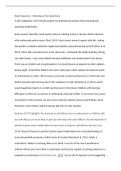Math Assignment – Reflecting on Past Experiences
In this assignment I will critically analyse my professional practice when teaching and
assessing mathematics.
Early research describes math anxiety (MA) as a feeling of fear or tension which interferes
with mathematic performance (Park, 2014). More recent research agrees with this, stating
the positive correlation between negative perceptions towards learning and MA (Zhou et al,
2019). MA is still a prevalent issue in the classroom, I witnessed this whilst teaching. During
my math lessons, I saw some children became withdrawn and uninterested in the lesson.
There was an evident lack of participation in my math lessons as opposed to other subjects
being taught. I found that children who were achieving in other subjects showed low levels
of achievement in maths. MA has been connected to lower performance in math tasks and
beliefs towards math learning due to the avoidance of math (Maloney et al, 2011), which
would negatively impact on a child’s performance in the future. Children with learning
difficulties or MA have no interest in mathematics Baroody (2006). To overcome this, praise
and positive reinforcements can be used to motivate children (Aarnos and Perkkilä, 2012).
Therefore, in the future I will incorporate this into my own practice.
Bandura (1977) highlights the importance self-efficacy has on achievement as children with
low self-efficacy are more likely to give up when they find work difficult. The development of
positive teacher-pupil relationships has been seen to improve self-efficacy (Jerome at al,
2009). Research based on positive teacher-pupil relationships have concluded feelings of
trust and positivity promote a child’s sense of security (Roorda et al. 2011), which is
essential for children’s learning (Zhou et al, 2019). In terms of MA, this is beneficial as
children will become more likely to participate and become capable of solving problems in a
supportive environment (McCormick et al., 2013). Da Luz (2015) expands on this suggesting
, the teacher-pupil relationships raise a child’s intrinsic motivation to learn. More recent
studies have also been able to confirm the positive impact supportive teacher-pupil
relationships have on mathematic achievement (Kaskens et al., 2020; Zhou et al,2019). In
future practice, I will aim to build on these relationships with children which I believe is
done by knowing pupils better.
My lesson objectives heavily focused on problem-solving and fluency (Appendix 1). Although
a range of problem solving strategies are used to solve math questions, advanced based
memory strategies are vital as they provide the foundation for more complex problems
(Carr & Alexeev, 2011 ). These strategies heavily rely on a child’s working memory (WM).
(Ramirez et al, 2016) has found children with MA are seen to struggle with understanding
and completing problem solving questions due to the draining effects MA has on WM
(Maloney and Beilock, 2012). As expected, children with a lower WM generally fail to deploy
problem solving strategies and indeed have a lower achievement in math as opposed to
their peers (DeCaro et al, 2008). As mentioned earlier, children who were achieving in other
subjects were not achieving as highly in math. To be critical, If MA is the reason different
working memory resources are used to support advanced memory-based strategies, then
children with a higher WM might find It harder to use strategies that they have never used
before (Vukovic et al, 2013. A high level of MA may actually reduce the effectiveness and
use of strategies that help high children to perform at a high level. Therefore, children with
low WM might be less inclined to MA as they rely on easier strategies which do not rely on
WM and are associated with low achievement in math (Ramirez et al., 2016). My lessons
also included aspects of fluency; yet no relevant links have been found to link math anxiety
to a decline in arithmetic fluency (Timmerman et al, 2017).




